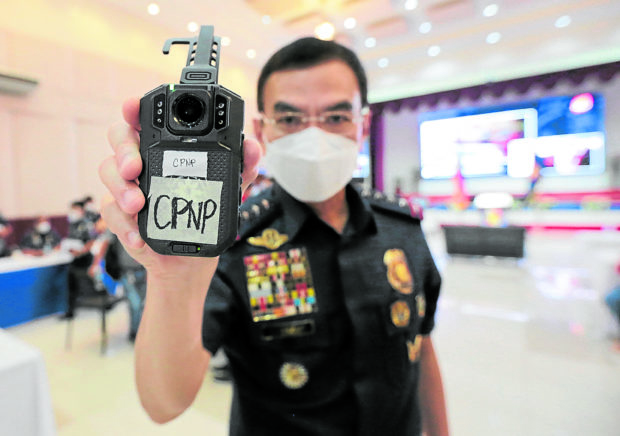
Philippine National Police (PNP) Chief Gen. Guillermo Eleazar, shows the Body Worn Camera System (BWCS) during its launching at a press conference on Friday, June 4, 2021, at Camp Crame in Quezon City. (Photo by GRIG C. MONTEGRANDE / Philippine Daily Inquirer)
MANILA, Philippines — The Supreme Court assured the Philippine National Police that the special rules mandating the use of body-worn cameras by police officers would not compromise their duties as law enforcers tasked with implementing orders by the courts.
Chief Justice Alexander Gesmundo told PNP chief Guillermo Eleazar that other members of the high tribunal had already presented their proposals and comments on the draft rules submitted by Associate Justice Marvic Leonen.
“This was to strike a delicate balance between protecting an individual’s constitutional rights on arrest, search and seizure, and ensuring the unhampered operational requirements of law enforcers in the execution of laws,” Gesmundo said during a meeting on Friday with Eleazar and other top PNP officials who paid a courtesy call on the Chief Justice.
He said the rules would be “out soon.”
The high court last month announced that it would require officers to wear cameras following the deaths of political activists in allegedly questionable circumstances when the police tried to serve search and arrest warrants against them.
‘Rights, responsibilities’
The rules on the use of police cameras would accompany broader policies to protect judges and lawyers against harassment and violent attacks.
It said the guidelines on body-worn cameras would also spell out the requirements for judges in granting warrants, which the PNP personnel should also observe.
“We assure you that the court will do its part in ensuring that the … rights guaranteed under the Constitution, as well as your responsibilities and duties as law enforcers, are properly considered and balanced,” Gesmundo told the PNP officials.
“We try to achieve that balance so that the end goal is we do not disregard the constitutional rights of people, but at the same time, the law enforcers are also given adequate leeway to effectively discharge your functions. That’s the main goal of this special rule that we are coming out,” he said.
Leonen, Associate Justices Rodil Zalameda, Samuel Gaerlan and Jhosep Lopez, Court Administrator Jose Midas Marquez and Supreme Court spokesperson Brian Keith Hosaka, joined the Chief Justice in the meeting. Associate Justice Rosmari Carandang took part through videoconference.
Eleazar was accompanied by Police Maj. Gen. Arnel Escobal of the PNP Directorate for Investigation and Detective Management, Police Brig. Gen. Ferdinand Fuentes of the Police Security and Protection Group and Police Brig. Gen. Albert Ferro of the PNP Criminal Investigation and Detection Group.
Pushed after Kian slay
The use of the body cameras was proposed early in the Duterte administration in the wake of the thousands killed in the war on drugs where suspects had been gunned down as they allegedly fought against arresting officers.
Following the killing of 17-year-old Kian delos Santos in Caloocan City in August 2017, senators and congressmen filed separate bills to require law enforcers to use body-worn cameras in police operations.
In November 2018, three officers were convicted of murdering the teenager, whom they had falsely tagged as a drug suspect who allegedly fought back (“nanlaban”).
Congress allocated P334 million in the PNP’s 2018 budget to purchase cameras. In December 2019 the PNP awarded a P289-million contract to EVI Distribution, a company based in San Juan City, to provide around 2,600 body-worn cameras.
After a long delay, in February this year, more than 100 officers under the National Capital Region Police Office were trained on the use of the cameras that the PNP purchased in 2019.For transparency
The cameras are intended to help ensure transparency and accountability in police operations, particularly when the conduct and legality of certain raids, arrests or other anticrime activities are called into question.
The PNP is currently following the guidelines spelled out in a January 2019 memorandum signed by former PNP chief Ronald dela Rosa, who is now a senator.
When to use them
The memorandum said: “When available, the use of body camera and other gadgets to record all anti-illegal drug operations is encouraged.”
Pending the final guidelines, Eleazar ordered police commanders to use the body-worn cameras “as they see fit.”
According to the memo, the cameras will be used in the following: anti-illegal drug operations, except where operatives act as poser buyers; serving search and arrest warrants; hostage rescue operations; high-risk checkpoint operations; security operations during the implementation of orders and decisions of courts, and quasi-judicial and administrative bodies; and security coverage during major events, including the upcoming State of the Nation Address.
Only 171 PNP stations around the country have cameras for their personnel and only 623 officers of the 220,000-strong force had been trained to use them.
Each of these 171 stations received 16 cameras but only four of them are equipped with SIM cards that allow the officers to show live video recordings.
During a demonstration on June 4, Eleazar and other PNP officers at Camp Crame watched on livestream the arrest of a real murder suspect.

